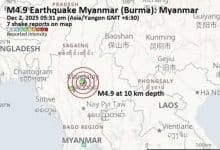Earthquake investigation uncovers overlooked fault line behind 4.5 magnitude tremor in northern Thailand

Phitsanulok and Pichit provinces, situated in the north of Thailand, were recently shaken by a significant earthquake, rated 4.5 on the Richter scale. The tremors caused noticeable damage to various buildings, including residences, religious sites, schools, and a hospital. As the earthquake investigation progresses, the fault line is currently under scrutiny by the Department of Mineral Resources and is suspected to be responsible for these tremors.
Suvapak Imsamut, Deputy Chief and spokesperson for the department addressed the situation in a news conference held yesterday. He informed the public of the department’s keen interest and ongoing earthquake investigation concerning the tremors that occurred late last week. Suvapak said…
“Our previous stance was that this hidden fault remains inactive. Nevertheless, it might be necessary to shift it to the active fault list. This move, however, will only follow after comprehensive analysis and official approval of our findings.”
Suvapak also mentioned the categorisation of Phitsanulok province under the Department of Public Works and Town & Country Planning as a “green zone” indicating the region’s vulnerability and needing quake-induced damage control methods.
The originating point of the earthquake was traced back to the Bang Krathum district in Phitsanulok, a location which hasn’t recorded a tremor for the past century. Surprisingly, there was only one aftershock, registered at 1.6 on the Richter scale, which ensued a mere 20 minutes later after the primary jolt. This sudden event has taken geologists by surprise, primarily since the fault responsible for the quake, approximately 100 metres deep, was mostly unknown until now, admits Suvapak.
Suwit Kohsuwan, an expert from the department, shared his team’s analysis from the data gathered from the 20 nearby earthquake measurement stations. They identified this elusive fault line running north-south in the Phetchabun Mountains zone. Consequently, the organization has established 26 mobile earthquake measurement stations to ascertain the fault line’s length as it has crucial implications for the potential magnitude of future quakes, reported Bangkok Post. Suwit said…
“The length of the fault is directly proportional to the scale of the vibrations. Therefore, a large fault will likely produce more powerful tremors.”
Suwit acknowledged the challenges in locating the fault but emphasized the crucial necessity for its discovery due to the potential risks to surrounding communities. Intriguingly, he mentioned that despite only recorded quakes this century, the existence of this fault was talked about over 440 years ago, during King Naresuan’s reign in Ayutthaya.
Terming the situation as “interesting,” Suwit notes this to be the first instance of a hidden fault yielding a 4.5 reading on the Richter scale. Usually, such undisclosed faults register a lower score, typically between 1 to 2. He also verified the substantial impact of the earthquake, confirming damage to 22 buildings, including homes, temples, schools, and a healthcare facility.
Latest Thailand News
Follow The Thaiger on Google News:


























